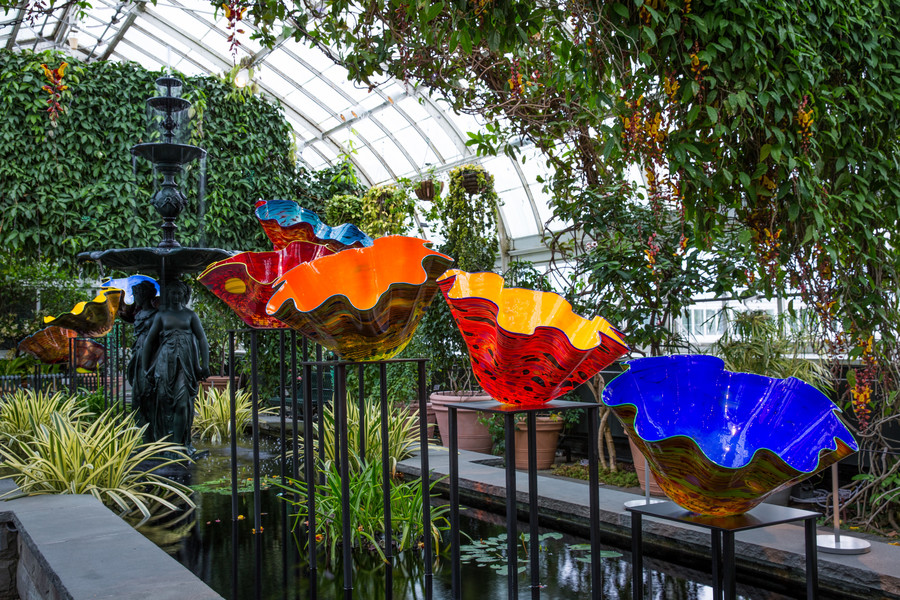Long history of glassworking leads to Chihuly exhibit
Magic does not happen very often, but sometimes the familiar is radically and splendidly transformed.
Once again, the New York Botanical Garden is bringing a special artist to a special place, and the public is invited. Dale Chihuly is one of the world’s premier glass artists, and has worked on this exhibit for two years.
I have been fascinated for years by art glass. Corning — home of Corning Glass Works — is a mecca for enthusiasts with demonstrations of glassworking and a multitude of classes. Closer to home, Urban Glass in Brooklyn and Bullseye Resource Center New York in Mamaroneck also offer classes.
The superlative Corning Museum of Glass has a permanent glass collection as well as special exhibits.
Glassmaking began about 4,000 years ago and may have originated in Mesopotamia, although many of our preserved objects are from ancient Egypt. Glass was unknown to the indigenous peoples of the Americas. Even the highly advanced civilizations of Middle and South America were only familiar with obsidian, the volcanic black glass that they shaped into cutting tools and weapons.
Glass in the Old World was used for art objects, drinking ware and as beads, which were an inexpensive substitute for those made from semi-precious stones. Glass windows, albeit of poor quality, already were produced by the Romans and were used in villas at Pompeii which was destroyed in A.D. 79.
Window glass, though, only became common in England in the early 17th century.
Stained glass windows were being used quite early in churches. An example of early Church glass comes from St. Paul’s Monastery in Jarrow, England, which was founded in A.D. 686. The stained glass tradition continued during the Middle Ages and can be seen in churches throughout Europe.
Arabian glass windows can be documented from the latter half of the 13th century.
Glass, however, has continued to evolve as a creative material with a variety of new techniques introduced in the late 19th century. Tiffany decorative glass panels — developed and produced between 1878 and 1933 — can be seen at the Metropolitan Museum of Art.
Other Art Nouveau glass artists include Rene Lalique, the Daum family and Emile Galle. Striking botanical glass creations — produced between 1887 and 1936 by the father and son team of Leopold and Rudolf Blaschka — are now on permanent exhibit at the Harvard Museum of Natural History. They consist of 847 life-sized models from 164 plant families.
The American studio glass movement was born in 1962 under the tutelage of Harvey Littleton through two workshops he gave at the Toledo Museum of Art. Before that time, due to technical issues, glass only could be worked in large factories. The studio glass movement, using smaller furnaces, brought the possibilities of art glass creations to smaller scale studios, and Dale Chihuly is one of the best-known students of that movement.
Just this week there was an announcement of producing glass objects using 3-D printing.
Rena De Sisto, global executive for arts and culture at Bank of America — a sponsor of the botanical garden exhibit — said art is an essential part of education, both for stimulating the imagination and creativity.
Chihuly aficionados will recognize his characteristic styles and motifs, although most of the installations were created for this show.
The environmental art movement focuses on the interplay of light and materials. Installations, that in the past would have a static impact based on an indoor location, now have an infinite number of moments as they stand outdoors subject to changing light as the sun progresses across the sky.
Since there also will be late evenings at the exhibit between 6:30 and 10:30, outdoor night lighting will add another exciting dimension.
The installations have been sited in various locations throughout the botanical garden. The exhibition space in the Conservatory is filled with pieces interspersed with flowers highlighting or contrasting the pieces sprouting in their midst. There are additional pieces in the outdoor lily ponds and the tropical areas.
The most dramatic presentation is in the Palm Court entrance with red and orange floating “lily pads,” and blue and white water birds feeding behind them.
The Native Plant Garden has two installations where water reflections are vital parts of the vision. In addition, there are pieces in front of the library building and near the rock garden.
In the library gallery on the sixth floor, there is an exhibition accompanied by the preliminary drawings.






